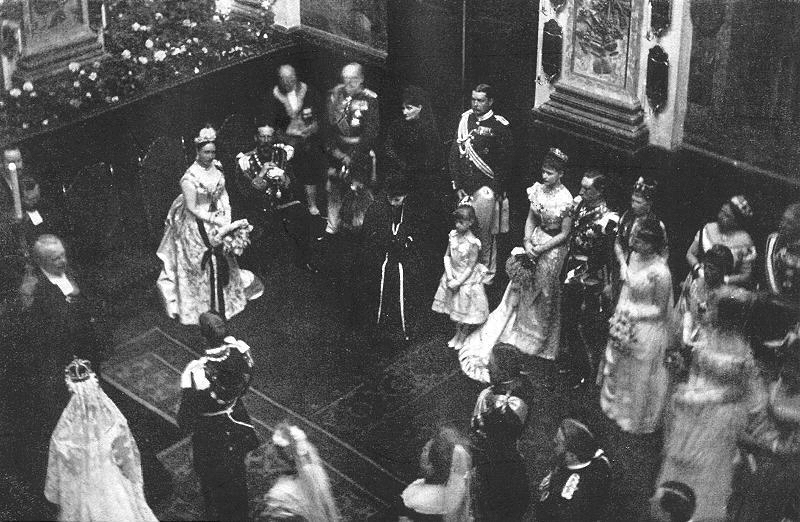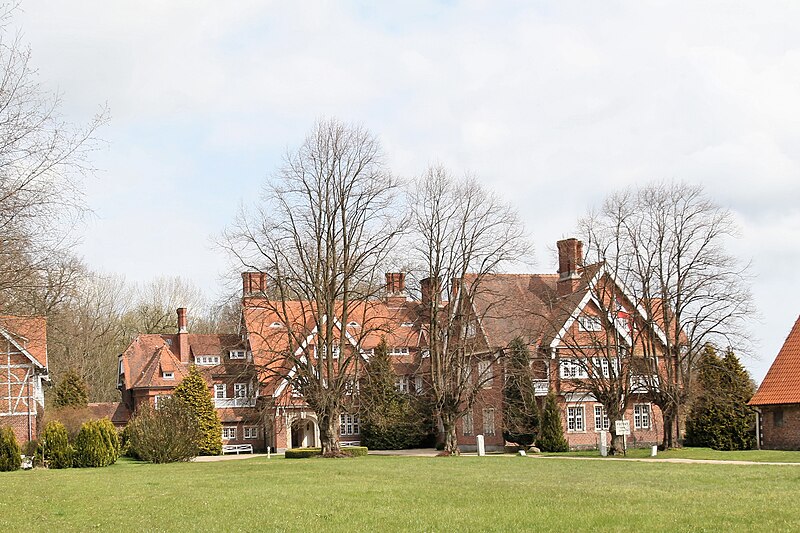by Scott Mehl © Unofficial Royalty 2015

Source: Wikipedia
Princess Alix of Hesse and by Rhine, Empress Alexandra Feodorovna of Russia
Queen Victoria’s 23rd grandchild, Princess Alix of Hesse and by Rhine, is perhaps remembered best as Alexandra Feodorovna, the last Empress of Russia. She was born on June 6, 1872, at the Neues Palais in Darmstadt, Grand Duchy of Hesse and by Rhine, now in Hesse, Germany, the sixth of seven children of Princess Alice of the United Kingdom and Grand Duke Ludwig IV of Hesse and by Rhine.
She was christened Alix Victoria Helena Luise Beatrice – named for her mother and her four maternal aunts – on July 1, 1872 (her parents’ tenth wedding anniversary) with the following godparents:
Alix had six siblings:
- Victoria of Hesse and by Rhine, Marchioness of Milford Haven (1863-1950), married Prince Louis of Battenberg, had two daughters and two sons
- Elisabeth of Hesse and by Rhine, Grand Duchess Elizabeth Feodorovna of Russia (1864-1919), married Grand Duke Sergei Alexandrovich of Russia, no children
- Irene of Hesse and by Rhine, Princess of Prussia (1866-1953), married her first cousin Prince Heinrich of Prussia, had three sons
- Ernst Ludwig, Grand Duke of Hesse (1868-1937), married (1) his first cousin Princess Victoria Melita of Saxe-Coburg and Gotha, had one daughter, divorced (2) Princess Eleonore of Solms-Hohensolms-Lich, had two sons
- Prince Friedrich of Hesse and by Rhine (1870-1873), hemophiliac, died after a fall
- Princess Marie of Hesse and by Rhine (1874-1878), died from diphtheria

Hesse and by Rhine family in 1876; Photo Credit – Wikipedia
Nicknamed Sunny, she was, by all accounts, a happy and beautiful child. She was very close to her brother Ernie and would remain so throughout her life. The family lived a rather simple life, as they were not very wealthy by royal standards. In 1877, Alix’s father became the reigning Grand Duke, but the children’s lives remained mostly unchanged. They spent time with Queen Victoria each year, relishing their visits to ‘Grandmama’ and looking forward to the next one. This relationship would become even closer in the coming years.
In 1878, most of the family became ill with diphtheria. Sadly, Alix’s younger sister, May, succumbed to the illness, followed a few weeks later by their mother, Princess Alice. Queen Victoria stepped in to serve as a surrogate mother to the children, managing nearly every detail of their lives.
In 1884, Alix went to St. Petersburg, Russia to attend the wedding of her sister Princess Elisabeth of Hesse and by Rhine and Grand Duke Sergei Alexandrovich of Russia. Also in attendance was the groom’s nephew Tsesarevich Nicholas Alexandrovich, the heir of Alexander III, Emperor of All Russia. It was at this wedding that Alix and Nicholas first met. The two were second cousins through their mutual great-grandparents, Ludwig II, Grand Duke of Hesse and by Rhine and his wife Wilhelmine of Baden. It would be five years later, while Alix was visiting her sister in Russia, that the two would fall in love.
The prospect of marriage was met with much opposition from both Nicholas’ parents of Alexander III, Emperor of All Russia and Empress Maria Feodorovna (born Princess Dagmar of Denmark), and Alix’s grandmother Queen Victoria. The Emperor and Empress felt that Alix was not suitable enough for their son, in part because of their dislike and distrust for all things German. They also hoped for a ‘higher profile’ bride and future Empress. As for Queen Victoria, she quite liked Nicholas personally. However, the same could not be said for his father, or for Russia itself. She also felt uneasy about another of her granddaughters marrying into the Russian Imperial Family. Queen Victoria had promoted marriage between Alix and her first cousin Prince Albert Victor of Wales, but Alix showed no interest. However, she was quite fond of her granddaughter and eventually gave into Alix’s wishes.
Despite the misgivings of their respective families, the couple became engaged in April 1894, while in Coburg, Duchy of Saxe-Coburg and Gotha attending the wedding of Alix’s brother. Nicholas was representing his father at the wedding of Alix’s brother Grand Duke Ernst Ludwig of Hesse and by Rhine to Princess Victoria Melita of Edinburgh and Saxe-Coburg and Gotha, Alix and Nicholas’ mutual first cousin. At first, Alix refused his proposal, as she was a devout Lutheran and was unwilling to convert to Russian Orthodoxy as would be required. However, after some urging from her elder sister who had married into the Romanov family, Alix relented and accepted. The wedding was planned for the spring of 1895.

Engagement photo of Alix and Nicholas, 1894. Source: Wikipedia
Sadly, in the fall of 1894, Nicholas’ father fell ill. Sensing that there was not much time left, Alexander III instructed Nicholas to send for Alix, who arrived on October 22nd. Despite his ailing health, Emperor Alexander III insisted on greeting her in full uniform and gave her his blessing. Alexander III died just ten days later, leaving the 26-year-old Nicholas as the new Emperor of All Russia. The following day, Alix was received into the Orthodox Church, taking the name Grand Duchess Alexandra Feodorovna. Nicholas initially wanted to marry immediately, even before his father’s funeral, in a private ceremony. However, he was convinced that as Emperor, he should marry in St. Petersburg with at least some of the pomp and ceremony that was traditional in the Russian Imperial Family.

The wedding of Nicholas and Alexandra, painting by Laurits Tuxen. Source: Wikipedia
Emperor Alexander III died on November 1, 1894, leaving Nicholas as the new Emperor Nicholas II. The following day, Alix was received into the Russian Orthodox Church and was given the name Grand Duchess Alexandra Feodorovna. Although originally planning to marry the following spring, the wedding was quickly arranged and the couple married on November 26, 1894, in the Grand Church of the Winter Palace. The young princess from Darmstadt was now Empress of All the Russians. Over the next ten years, the couple had five children:
Alexandra found it very difficult to relate to the Russian people and was perceived as being very haughty and aloof. Those who knew her attribute this to her extreme shyness. This was magnified by the drastic difference in the personality of her mother-in-law, the Dowager Empress Maria Feodorovna, who was very outgoing and greatly loved. Alix was also met with distrust by the Russian people, due to her German roots. This would be greatly magnified in years to come, during World War I.
Anna Alexandrovna Vyrubova became started as a maid of honor at the Winter Palace in St. Petersburg in 1903, serving various female members of the Romanov family. In 1905, Anna was summoned to Tsarskoye Selo, the town containing residences of the Imperial Family located 15 miles south of St. Petersburg, to fill in for a lady-in-waiting to Alexandra who became ill. Thus began her longtime relationship with Alexandra. Anna became a close friend of Alexandra, was close to the Imperial Family for many years, accompanied them on many trips, and attended private family events. Anna wrote about her experiences in her memoir, Memoirs of the Russian Court, published in 1923 and still available.
Having had four daughters, Alexandra felt great pressure to provide an heir. Finally, in 1904, she gave birth to a son, Alexei. However, it would soon become apparent that she was a carrier of hemophilia, and her young son was a sufferer. This would cause great pain to the Empress, and great measures were taken to protect him from harm and to hide the illness from the people. When it eventually became public knowledge, it led to more dislike for the Empress, with many of the Russian people blaming her for the heir’s illness. See Unofficial Royalty: Hemophilia in Queen Victoria’s Descendants.
After working with many physicians to help Alexei, the Empress turned to mystics and faith healers. This led to her close, and disastrous, relationship with Grigori Yefimovich Rasputin. Several times he appeared to have brought the Tsarevich back from the brink of death, which further cemented Alexandra’s reliance. To many historians and experts, this relationship would contribute greatly to the fall of the Russian monarchy. In December 1916, Grand Duke Dmitri Pavlovich, the first cousin of Nicholas II, was one of the conspirators in the murder of Rasputin. For more information see Unofficial Royalty: Murder of Grigori Yefimovich Rasputin.
During World War I, in March 1917, Nicholas was forced to abdicate. The family was held under house arrest first at the Alexander Palace at Tsarskoe Selo and later in Tobolsk in Siberia. Following the Bolshevik Revolution in 1917, they were moved to the Ipatiev House in Yekaterinburg. It was here on the morning of July 17, 1918, that the family was brought to a room in the basement and assassinated. Their bodies were initially thrown down a mine, then retrieved and hastily buried.
In 1979, a mass grave was discovered, believed to include the remains of the Imperial Family. They were exhumed in 1991, and in 1998, through DNA testing, it was announced that the remains were of Nicholas, Alexandra, and three of their daughters. On July 17, 1998 – 80 years to the day of their murders – the remains were interred in St. Catherine Chapel at the Peter and Paul Cathedral in St. Petersburg. The remains of the last two children were found in a nearby grave in 2007 and positively identified the following year. These remains have not yet been buried. The Russian Orthodox Church has questioned whether the remains are authentic and blocked the burial. For more information see July 17, 1918 – Execution of Nicholas II, Emperor of All Russia and His Family

St Catherine Chapel at the Peter and Paul Cathedral where the Imperial Family is interred; Source: Wikipedia
This article is the intellectual property of Unofficial Royalty and is NOT TO BE COPIED, EDITED, OR POSTED IN ANY FORM ON ANOTHER WEBSITE under any circumstances. It is permissible to use a link that directs to Unofficial Royalty.
Romanov Resources at Unofficial Royalty

























